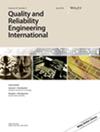针对 7 因子和 8 因子无混淆 16 次分数因子设计的别名信息模型选择 (AIMS)
IF 2.8
3区 工程技术
Q3 ENGINEERING, INDUSTRIAL
引用次数: 0
摘要
非规则分因子设计是规则解析 IV 设计的一个可取替代方案,因为它们可以避免混淆的 2 因 子相互作用。因此,非规则设计可以估计和识别少数活跃的 2 因子交互作用。然而,由于非规则设计的别名结构有时很复杂,标准的因素筛选策略可能无法识别所有活跃效应。我们报告了一种利用这些非规则设计的别名结构的筛选技术。这种别名知情模型选择(AIMS)技术以前曾用于特定的 6 因子非规则设计。我们展示了如何将 AIMS 技术应用于 7 因子和 8 因子非规则设计,从而完成了该方法在所有 16 次运行的 2 级设计中的应用,这些设计是标准 Resolution IV 小数因子设计的可行替代方案。我们将 AIMS 与其他三种用于非规则设计的标准分析方法(逐步回归、套索和 Dantzig 选择器)进行了比较。在确定有效因子集方面,AIMS 始终优于这些方法。本文章由计算机程序翻译,如有差异,请以英文原文为准。
Alias‐informed model selection (AIMS) for 7 and 8 factor no‐confounding 16‐run fractional factorial designs
Nonregular fractional factorial designs are a preferable alternative to regular resolution IV designs because they avoid confounding 2‐factor interactions. As a result, nonregular designs can estimate and identify a few active 2‐factor interactions. However, due to the sometimes complex alias structure of nonregular designs, standard factor screening strategies can fail to identify all active effects. We report on a screening technique that takes advantage of the alias structure of these nonregular designs. This alias‐informed‐model‐selection (AIMS) technique has been used previously for a specific 6‐factor nonregular design. We show how the AIMS technique can be applied to 7‐ and 8‐factor nonregular designs, completing the exposition of this method for all 16‐run 2‐level designs that are viable alternatives to standard Resolution IV fractional factorial designs. We compare AIMS to three other standard analysis methods for nonregular designs, stepwise regression, the lasso, and the Dantzig selector. AIMS consistently outperforms these methods in identifying the set of active factors.
求助全文
通过发布文献求助,成功后即可免费获取论文全文。
去求助
来源期刊
CiteScore
4.90
自引率
21.70%
发文量
181
审稿时长
6 months
期刊介绍:
Quality and Reliability Engineering International is a journal devoted to practical engineering aspects of quality and reliability. A refereed technical journal published eight times per year, it covers the development and practical application of existing theoretical methods, research and industrial practices. Articles in the journal will be concerned with case studies, tutorial-type reviews and also with applications of new or well-known theory to the solution of actual quality and reliability problems in engineering.
Papers describing the use of mathematical and statistical tools to solve real life industrial problems are encouraged, provided that the emphasis is placed on practical applications and demonstrated case studies.
The scope of the journal is intended to include components, physics of failure, equipment and systems from the fields of electronic, electrical, mechanical and systems engineering. The areas of communications, aerospace, automotive, railways, shipboard equipment, control engineering and consumer products are all covered by the journal.
Quality and reliability of hardware as well as software are covered. Papers on software engineering and its impact on product quality and reliability are encouraged. The journal will also cover the management of quality and reliability in the engineering industry.
Special issues on a variety of key topics are published every year and contribute to the enhancement of Quality and Reliability Engineering International as a major reference in its field.

 求助内容:
求助内容: 应助结果提醒方式:
应助结果提醒方式:


